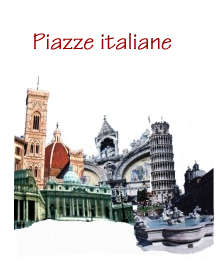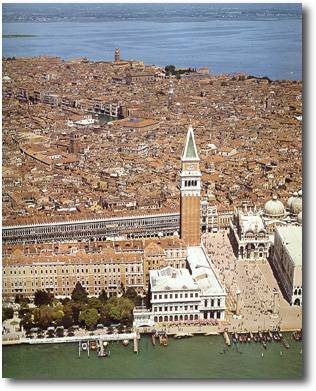
SAINT MARK'S SQUARE
Saint Mark's Square is the only true square in Venice because the other open areas are campi. It consists of an artistic complex of buildings in different styles that over time have created a harmonious setting to the square. St. Mark's Square was called "the drawing room of the world" by Musset. It has been the scene of some of the most important religious and political activities of the Serenissima as well as the center of Venetian social life for almost a millennium. In this place there is the Doge's Palace. The entrance is through the Porta della Carta. This is a monumental entrance in floral Gothic style that contains two bronze well-curbs. The courtyard is surrounded by porticoes with a top loggia. On the eastern side there is the Scala dei Giganti. It is thus called because of the two enormous statues by Sansovino at the sides. The stairway goes up to the loggia but to reach the top floors we go up the Scala d'Oro. It owes it name to the lavish frescoes and gilded stuccowork. It was from the Doge's Palace that the Venetian Republic was ruled and it is still the highest expression of Venetian art. It was the residence of the Doge and the seat of the main government departments. As one walks through its rooms the history and glory of the Venetian Republic is revealed in its paintings and sculptures. Next to the Doge's Palace there is Saint mark's Basilica, which could at one more time be reached from inside the Palace. The Basilica is a wonderful example of Byzantine Venetian architecture. It was at one time the Doge's chapel but it was also the mausoleum for Saint Mark, the patron Saint, whose life is narrated in the golden mosaics on the walls. Finally, there is Saint Mark's Square. It is trapezoidal, and the Procuratie Vecchie and Procuratie Nuove run along the two extensive sides. They are known as old and new on the basis of the age of the buildings over the arcades of the ground-level porticoes. The Procuratie Vecchie runs along the north side of the square from the Clocktower and have kept their Renaissance features. They are followed by the Ala Napoleonica. This was built in 1810 by the architect Giuseppe Soli on the side of the demolished San Geminiano church, which was built by Sansovino. The Procuratie Nuove runs along the west side of the square and includes the Libreria di San Marco, which was des8igned by Jacopo Sansovino at the request of the Venetian Republic to house the codicils donated to it by Cardinal Bessarione. The clocktower is at the start of the Merceria, the road that leads from Saint Mark's Square to the Campo di San Bartolomeo.
Authors: Virginia
